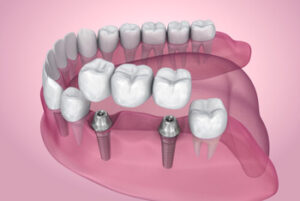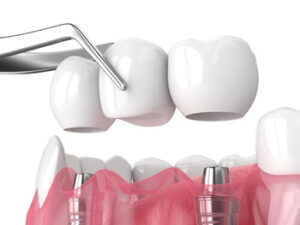Losing a tooth can make simple things like eating or speaking feel different. A dental bridge provides a secure solution, allowing you to enjoy a complete smile. But how much does it actually cost? The price can change depending on different things, and knowing these details can help in making the right choice.
What Is a Dental Bridge?
A dental bridge helps to replace missing teeth by using nearby natural teeth for support. It can be used when one or more teeth are lost, creating a full smile again.
How Much Will a Dental Bridge Cost?
The cost in Australia for a simple dental bridge typically begins at approximately $1,500 for each tooth. Costs can differ depending on individual needs. Speaking with your dentist can help you get a tailored estimate and find the best option.
What Are the Factors That Determine the Cost of a Dental Bridge?
A variety of factors influence the dental bridge cost, making each treatment unique. The total price depends on the materials used, the number of missing teeth being replaced, and the complexity of the procedure.
 The Type of Bridge Affects the Price
The Type of Bridge Affects the Price
Different bridges come with varying costs depending on how they are supported. Traditional bridges use adjacent teeth for stability, while cantilever bridges rely on a single tooth for support. An implant-supported dental bridge, held in place by dental implants, can increase the overall expense. Maryland bridges, which use a framework for support, have their own pricing. Some bridges also require a dental crown for added strength, which can influence the total cost. The type chosen will play a major role in determining the final price of dental bridges.
Material Selection and Its Role in Pricing
The type of material used for a dental bridge greatly impacts the price. Ceramic and porcelain bridges are often chosen for a natural look, while metal-based options offer durability. Some bridges combine both materials, making them strong while still blending with natural teeth. Gold and zirconia are premium choices that may come at a higher cost. The right material depends on a person’s needs, budget, and aesthetic preferences.
The Number of Teeth Being Replaced
Larger bridges covering multiple spaces will generally be more expensive than those replacing a single missing tooth. More artificial teeth mean additional materials and a more complex design. If the bridge spans a long gap, extra support may be required, increasing the cost. A well-fitted bridge should restore both function and appearance. The number of replacement teeth directly affects the final price.
Condition of the Supporting Teeth
For a bridge to last, the surrounding teeth need to be strong enough to hold it in place. If adjacent teeth require fillings or crowns before placement, this will add to the expense. Weakened or damaged teeth may need additional dental treatment before they can support a bridge. In cases where existing teeth cannot provide enough support, dental implants may be suggested as an alternative. The health of surrounding teeth is an important factor in determining the final cost of dental bridges.
Extra Procedures That May Be Needed
Some patients may require additional treatments before a bridge can be placed. If a tooth needs to be extracted first, this will increase the total cost. In some cases, X-rays or scans are necessary to plan the treatment properly. Adjustments to the gums or jaw may also be needed to ensure a secure fit. Every extra step contributes to the final dental bridge price.
Planning for a Strong and Lasting Solution
The total price of a bridge depends on several factors, from the type of bridge to the materials and extra procedures required. Investing in a high-quality bridge can provide long-term benefits. Exploring different options with a dentist can help in choosing the best treatment. A well-made bridge offers stability, function, and a natural appearance, making it a worthwhile decision.
What Does the Dental Bridge Procedure Involve?
Restoring a missing tooth involves several steps to ensure a secure and natural fit. Careful planning and precise placement make the dental procedure effective and long-lasting. Once the bridge is in place, proper aftercare is essential to keep it in good condition.
Assessing Oral Health
Before beginning, the dentist assesses the oral health to confirm if a bridge is suitable. This includes checking the strength of the existing teeth that will support the bridge. X-rays or digital scans are taken to understand the alignment and structure of the mouth. If gum disease is present, it may need to be addressed before proceeding with the bridge. Once the examination is complete, the best type of bridge is selected to fit the specific needs of the patient. The preparation phase follows, where supporting teeth are shaped to hold the bridge securely.
Preparing the Abutment Teeth for Placement
To create a stable foundation, the abutment teeth must be adjusted. A small portion of the enamel is removed from these supporting teeth to make space for the bridge. This step ensures that the final restoration sits properly without affecting the bite. After shaping, impressions or digital scans are taken to create a bridge that fits perfectly. A temporary bridge may be placed to protect the prepared teeth while the permanent bridge is being crafted at a dental lab.
Placing the Final Bridge and Adjusting Fit
Once the custom bridge is ready, the temporary bridge is removed. The permanent bridge is then positioned and checked for fit. Any necessary adjustments are made to ensure comfort and a natural feel. Once everything is set, the bridge is bonded securely to the abutment teeth. The final step involves polishing the bridge and confirming that it aligns well with the surrounding teeth.
 Caring for a New Dental Bridge
Caring for a New Dental Bridge
After the dental bridge treatment procedure, following proper care routines helps maintain its strength. Keeping the area clean by brushing daily prevents plaque from building up. Using a special floss or interdental brush can help clean around the bridge more effectively. Regular dental examinations let the dentist monitor the bridge and ensure that it remains in excellent condition. Avoiding sticky or hard foods helps prevent unnecessary stress on the bridge.
Ensuring Long-Term Dental Health with a Bridge
A properly maintained bridge not only restores function but also supports dental health. It prevents nearby teeth from shifting and keeps the bite even. Any discomfort or looseness should be checked by a dentist as early as possible. Following the right care habits ensures that the bridge lasts for many years. A well-fitted bridge improves both function and appearance, making daily activities easier and more comfortable. False teeth used in the bridge are designed to blend naturally with real teeth, creating a seamless look.
Quality Treatment for Lasting Results
A well-fitted dental bridge can make a big difference in how your smile looks and feels. Finding the right option ensures comfort, function, and long-term benefits. The cost may vary, but getting quality care means lasting results. If you’re considering a dental bridge, speaking with a trusted team can help you understand your choices. Every smile deserves personalised care to achieve the best outcome. Our clinic is here to guide you through the process and offer the right solution for your needs. Call us today at 02 9051 0600 to book an appointment and explore the best options for your smile!
References
https://www.news-medical.net/health/Dental-Bridge-Procedure.aspx
https://www.healthdirect.gov.au/dental-bridge


 The Type of Bridge Affects the Price
The Type of Bridge Affects the Price Caring for a New Dental Bridge
Caring for a New Dental Bridge



